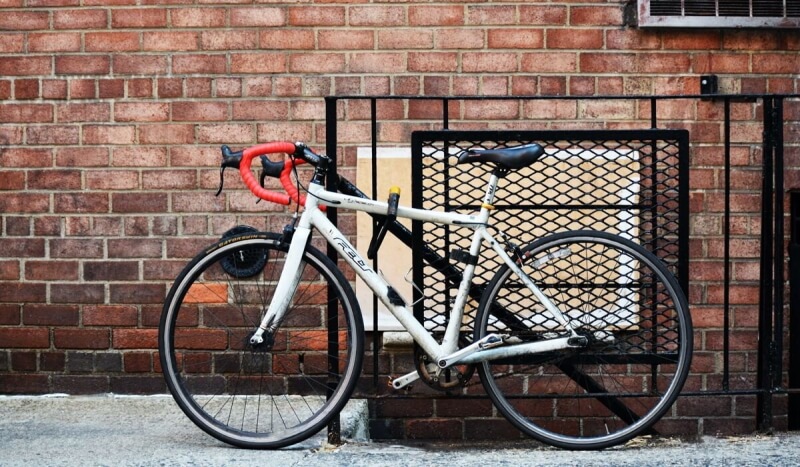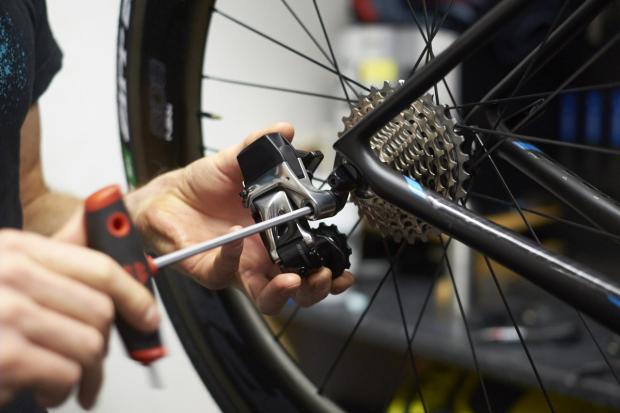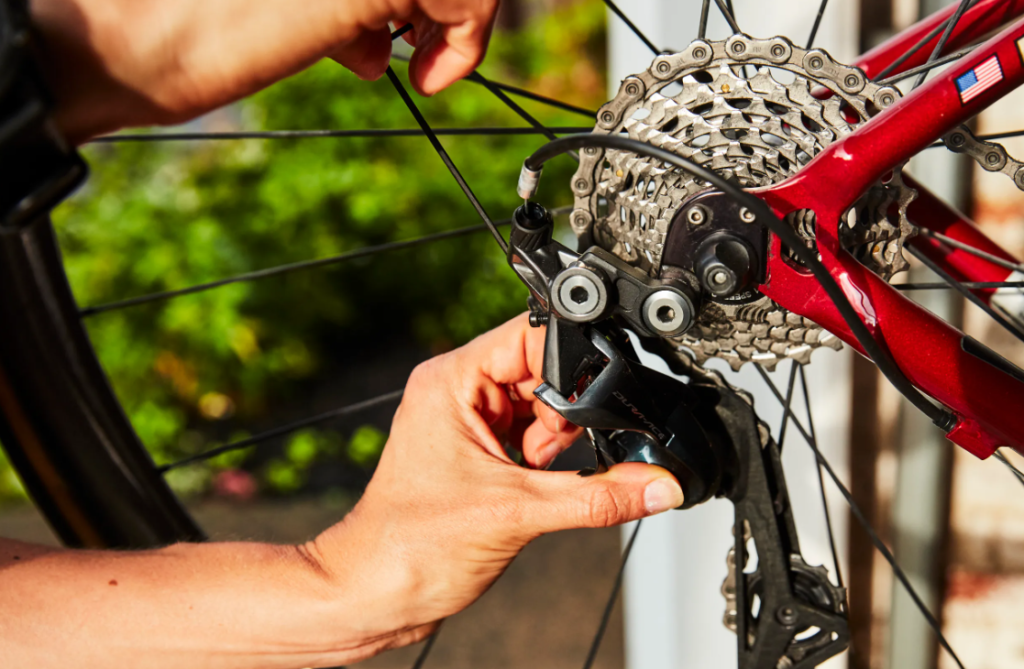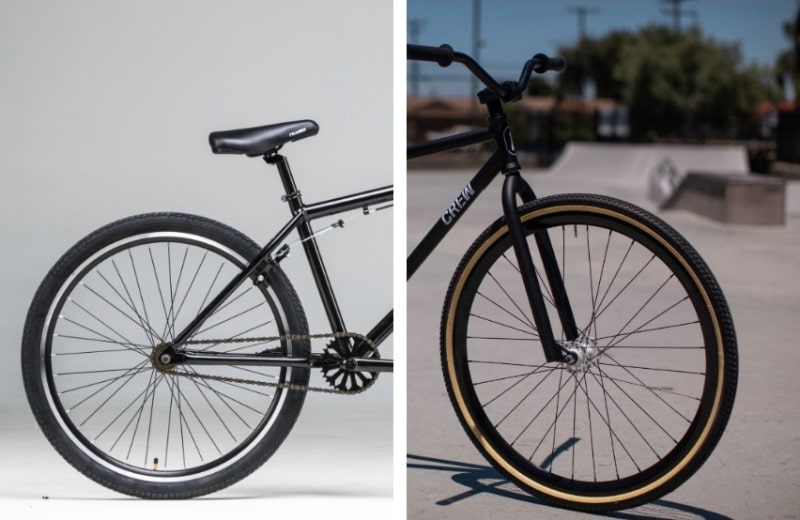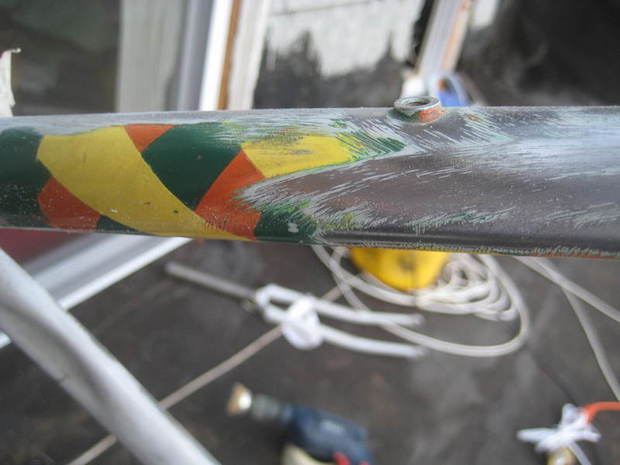- Trails
-
Bikes
-
Gear
-
Tips & Tricks
-
About us


Like car tires, whenever you need to replace bike tires, you can check the sides since the size is usually indicated. However, a big problem for those ordering online is that the 700c wheel size that’s sometimes printed on the tire may not translate into actionable information. After all, there are several different variations of 700c wheels. Also, 700c is not something you can measure at home since no tape measures support such measurement units. As such, sometimes, the only option is to convert 700c to inches. So, the big question is, what is the 700c wheel size in inches? We delve deeper into that below so you know exactly what size tires to order whenever you need replacements.
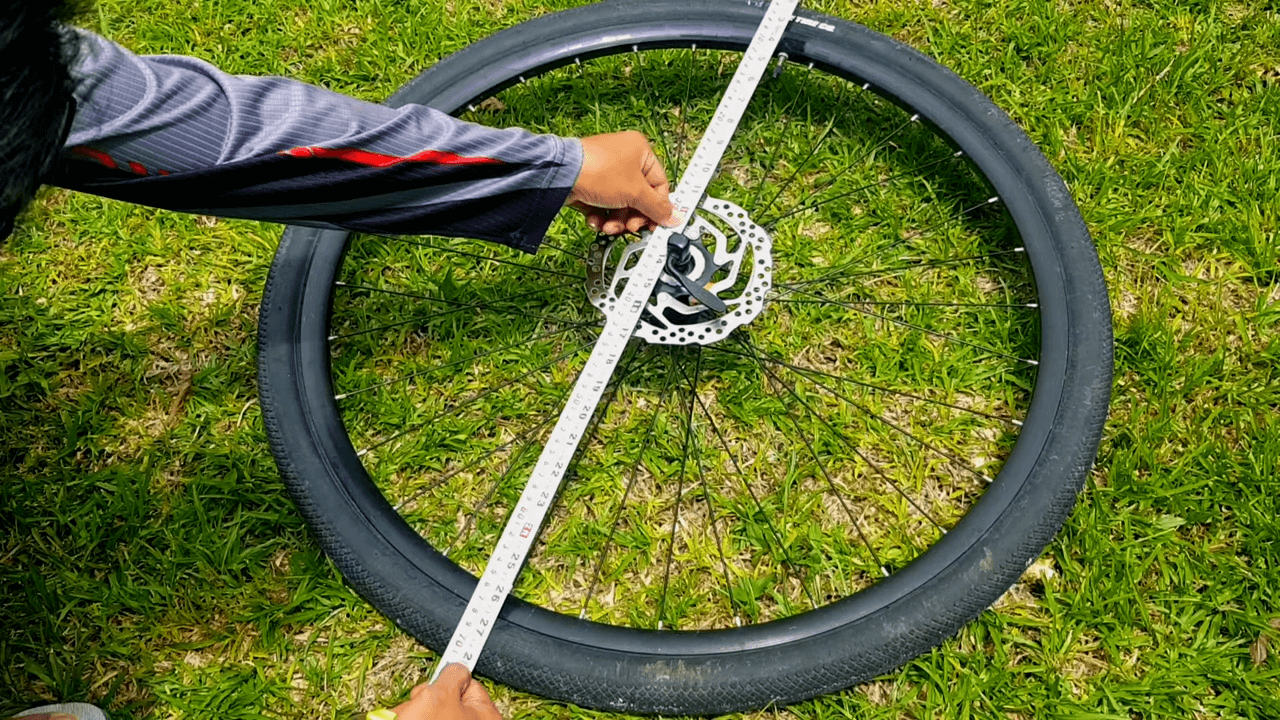
It was first introduced by the French as a wheel size in the 1890s. However, given that the wheels on the road and hybrid bikes are wildly different, it’s understandable why it would be confusing.
Originally the number 700 indicated the outer diameter of a wheel with the tires attached. However, currently, the fact that road bike wheel diameters are smaller than their hybrid counterparts, so why are there both 700c wheels?
Some notable differences explain these discrepancies. For instance, many road bike tires are practically treadless. On the other hand, hybrid tires may come with thick treads depending on the type of terrain they’re meant for. This further increases the outer diameter and means that discrepancies may even appear between some hybrid bike tires.
Also, road bike tires are made to be as small, lightweight, and aerodynamic as possible, while hybrid bike tires are designed to cater to different terrains.
However, it’s worth noting that the bead seat diameter is the same in all 700c wheels. The bead seat is the area between the wheel rims and comes at a standard 622mm. Therefore, while it may not be the meaning that was originally intended, currently, it’s safe to assume that all 700 tires have a 622mm diameter between the rims.
As for the c that comes after 700, it used to indicate French tire sizing with options from A to D, i.e., 700a, 700b, 700c, and 700d. Most 700a, 700b, and 700d options no longer appear in the market as much as the 700c, though you may still come across a few.
You may even have come across a different sizing option, such as 650b for gravel bikes. Notably, we also have a comparison for 650b vs. 700c tires for gravel bikes for those unsure of which option to pick.
These letters typically refer to the width of the tires when fully inflated. However, now that technology has changed with additional tire features like guard spikes, anti-collapse designs, etc., these measurements no longer apply, making them redundant.
Despite 700c still being included on the side of the tire, manufacturers now use the International Organization for Standardization Trusted Source Accident Statistics The main changes compared to the previous edition are www.stanfordchildrens.org , (ISO) measurement. As such, you’ll see the number 622 as part of the information on any 700c wheel to indicate the bead seat diameter
Another number is placed before the ISO measurement with a hyphen separating the two. For instance, you might see something like 37 – 622. Naturally, 622 represents the bead seat diameter, while the other number indicates the tire width.
How this reflects in a non-700c wheel is 28 – 642 or 37 – 642 in wheels that were previously sized as 700a. As such, you can see that while the bead seat diameter has remained constant, the width of the wheels varies, which explains the switch to ISO measurements.
Notably, current tire widths range from 19 mm to 45 mm, and you can typically tell which type of bike a tire is designed for by looking at the width. Tires that range from 19 to 28 mm are for road bikes. Those between 28 and 35 mm are for cyclocross bikes.
35 – 45 mm options are for gravel bikes though they also work for hybrid bikes. The Micargi 700c is an example of one of those hybrid options that come highly recommended by previous users due to the slightly wider tires that make for a more comfortable ride and can handle gravel much more easily.
While shopping, you may see these sizes as 700 x 18c, 700 x 19c, 700 x 20c, etc.; the second number typically indicates the width.
All the information above is useful but doesn’t explain the 700c wheel size in inches. In the past, you could have assumed that 700C tires measured 700mm and converted that to inches. This would have translated to 27.5 inches, but currently, it’s not as straightforward.
The width of these tires greatly influences the overall diameter of the wheels, and you’re just as likely to find one that’s over 28 inches as one that’s under 26 inches. 700 x 18C tire, for instance, is an ISO size 18 – 622 and has a 25.94-inch diameter.
On the other hand, a 700 x 25C diameter is ISO size 25 – 622 and has a diameter of 26,38 inches or 67 cm. You can check out the table below for a full list of conversions.
|
Tire Size |
ISO Size |
Tire Diameter (Inches) |
Tire Diameter (Centimeters) |
| 700 x 18C | 18-622 | 25.94 | 65.89 |
| 700 x 19C | 19-622 | 26.06 | 66.2 |
| 700 x 20C | 20-622 | 26.14 | 66.39 |
| 700 x 23C | 23-622 | 26.27 | 66.72 |
| 700 x 25C | 25-622 | 26.38 | 67 |
| 700C Tubular | – | 26.69 | 67.8 |
| 700 x 28C | 28-622 | 26.8 | 68 |
| 700 x 30C | 30-622 | 26.9 | 68.3 |
| 700 x 32C | 32-622 | 27 | 68.6 |
| 700 x 35C | 35-622 | 27.17 | 69 |
| 700 x 38C | 38-622 | 27.32 | 69.39 |
| 700 x 40C | 40-622 | 27.57 | 70.02 |
| 700 x 44C | 44-622 | 28.01 | 71.14 |
| 700 x 45C | 45-622 | 28.1 | 71.37 |
| 700 x 47C | 47-622 | 28.42 | 72.19 |
Away from the 700c indicated on bike tires, you may also see a wheel referred to as a 26er, a 27.5er, or a 29er. So now that you know the bicycle wheel size 700c in inches, you should also be able to tell apart these three wheels.
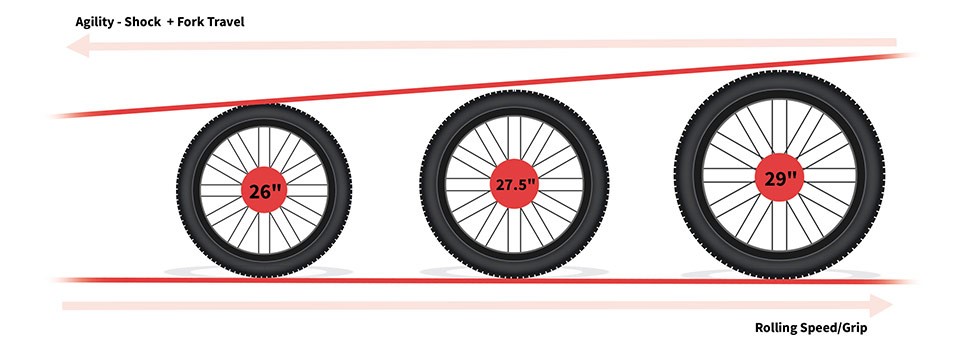
Before 2010, 26ers were among the most common wheel sizes for mountain and fat bikes, although their popularity recently waned. These are the smallest of the three and come with several perks, e.g., an ability to bear heavier loads and quick handling reactions.
Their compact size may have been a positive in some areas, e.g., when you needed to make quick turns. However, they also have downsides for current users. For instance, due to the small surface area touching the ground at any time, these wheels have the least traction out of the three options. Naturally, this also means they’re slower than the 27.5ers and 29ers.
Another con is the lack of durability in bumpy terrains; finally, they’re less than ideal for taller riders.
You can check out our 26 vs. 700c tires comparison for a quick explanation of the differences between the two.
As for the middling option, the 27.5ers, they combine the best of both worlds. They’re much more agile than 29ers but offer more traction and acceleration than 26ers. Additionally, they’re lighter, more portable than their larger counterparts, and more durable than the smaller alternative. In fact, most recreational cyclists prefer these wheels for their compatibility with almost any riding situation.
According to reviewers, one of the top-notch 27.5er bike options in the market is the Hiland 700c with an aluminum frame and lock-out suspension. The tires provided with this bike have a 40mm width.
29er tires are on the other end of the spectrum and differ most from their 26er counterparts. They’re the largest, and according to New Scientist Trusted Source Would taller people benefit from bicycles with larger wheels? Bicycle tyre size used to be a function of the height of the rider. This was true for the high-wheel bikes that became popular in the 1870s. www.newscientist.com , they have much less rolling resistance. As such, you can accelerate much quicker, and the best part is you don’t have to put in as much cycling effort as you would with a 26er or a 27.5er.
Perks of 29ers include excellent traction and fewer vibrations being transferred to the bike seat. On the other hand, their large size means they won’t be able to turn as quickly, so they are a bad bet whenever you tackle technical routes and trails.
The size also means the bikes are heavier, which can contribute to lower portability.
Ultimately, the point of converting the 700c wheel size to inches is so you can know which replacements to buy.
Naturally, for users whose “older” tires and wheels are still in relatively good condition, finding the tire size for your 700c wheels should be a cakewalk. Just pick one up and examine the sidewall markings. The ISO numbers should be printed there.
As mentioned above, the specs on your 700c wheels will show up in an XX – XXX configuration with the tire width preceding the bead seat diameter. Alternatively, you may see the sizing information indicated as 700 x XXc. The second number will typically range from 20 – 47 for 700C wheels.
Notably, if these numbers are faded, you shouldn’t try to guess the number as you might get it wrong and buy the wrong tire size. However, once you get the information you need, you can just match it up with the information in the table above so you can easily order the bicycle wheel size 700c in inches.
A more roundabout way of doing this is to go through your receipts and find the purchase details on your previous purchase. However, this only applies to those who keep all their purchase receipts, as they might be a little harder to find if you throw them in the trash.
If the details have rubbed off due to the tire’s age, you can still figure it out. For starters, most road bikes feature 700C tires, so more often than not, you can cross that off your checklist. Speaking of road bikes, if you’re also in the market for decent, affordable options, our list of best road bikes under $2000 is a free resource you can use.
However, if you’ve previously felt your wheels were slightly larger than those in other road bikes or are unsure, it should take you just a few seconds to make sure.
All you need to do is measure the bead seat diameter by putting your tape measure on the inside of the rim. The results should be 622mm.
As for the tire width, you’ll have to remove it from the rim and then measure the inside of the rim.
You can use a tape measure, although you want to ensure you’re only getting information from inside the rim. That said, the most effective tool for the job is a caliper, so if you can go for that, it’ll likely give you more accurate results.
Typically, an internal rim width between 13-15mm is designed for 700 x 23C tires.
Similarly, in the table above, you can get the conversion rates for all widths between 13 and 25 mm.
|
Internal Rim Width |
Tire Size Compatibility |
| 13-15, 17-19mm | 23 – 25c |
| 13-15, 17-19, 20-21, 22-23mm | 25 – 28c |
| 17-19, 20-21, 22-23, 24-25mm | 30 – 33c |
| 17-19, 20-21, 22-23, 24-25mm | 33 – 35c |
| 20-21, 22-23, 24-25mm | 38 – 40c |
| 20-21, 22-23, 24-25mm | 40 – 43c |
| 22-23, 24-25mm | 43 – 45c |
| 22-23, 24-25mm | 45 – 48c |
| 24-25mm | 48 – 50c |
Once you’ve matched your readings with the right bike wheel size 700c in inches, you can scour the web for compatible options.
Another common question is, do you need the exact tire size of your previous set? While it is recommended, you have some leeway to go wider, especially since most forks offer a bit of clearance between them and the tire treads. But why would you want a wider tire?
Well, typically, wider tires are better suited for rugged roads where the larger the contact area with the ground, the more stable the ride quality and the higher the traction you get. However, you don’t want to buy the tire before checking just how much leeway you have.
Notably, the caliper you used to measure the ideal tire width is the same tool you’ll use. With the previous tires and wheels attached, use the caliper to measure the distance between the tire and the front fork.
Similarly, you want to measure the distance between the rear tire and seat stays as well as the rear tire and the chain stays.
Remember, increasing the tire width will also increase the overall diameter. In 20-622, 23-622, and 25-622 tires, for instance, the wheel diameter is 66.39 cm, 66.72 cm, and 67 cm, respectively.
You want to maintain at least 3 mm of clearance for road bikes and more, i.e., 5-6 mm for gravel and hybrid bikes. If you can do that with a wider tire, there’s no reason not to get it.
Also, if your bike has fenders and panniers, it may be wise to consider getting the clearance reading on them as well.
Typically you need two tire levers to help you remove the tire and a pump to re-inflate your bike once you’ve replaced the tires. Sometimes, you might even need a valve removal tool based on the type of valve on your bike.
First, deflate the tube and remove the dust cap. For those using Presta valves which are the most common, remove the stem nut first before unthreading the lock nut at the top of the stem. After that, you can press the valve core to deflate the tire.
Schrader Trusted Source Timeline 1844: August Schrader starts a business making daguerreotype apparatus (silver plated copper photographic plates); he later expands his business to the production of brass turnings and parts. schrader-pacific.com valves only need you to remove the dust cap and press the valve core in the middle.
Once deflated, you press the sides of the tire towards the middle. This will loosen the tire bead from the sidewall of the rim. You can then insert the tire lever and lift it out of the rim. The only place you can’t do this is at the valve.
Use the second lever to lift out another section of the tire a few inches away. Keep repeating this until one side of the tire comes off. Push the other bead to the edge of the rim and repeat the process until the whole tire is out.
More often than not, it should come out with the tube.
As for the replacement part, put the tube into the new tire, adding enough pressure to hold its shape. Then align the two with the valve hole in the rim and insert it. Ensure the valve enters straight through and isn’t crooked. If it is, it’s likely to get damaged, leading to further problems.
After that, use your hands to push the rest of the tire onto the rim. With one bead installed, push the tube into the rim seat. This part of the process is often fairly straightforward.
Finally, push the other tire bead into the rim seat as well. You may need to use tire levers at the end. However, at this point, you should be careful not to pinch the inner tube as it can cause damage and force you to start over.
Inspect the tire. The tire bead should be uniform, and the inner tube should be firmly hidden in the rim seat. After that, inflate the tire and inspect the wheel again. If everything is okay, keep adding tire pressure until full.
Now you know how to convert 700c to inches, which should greatly help your shopping experience. For road and hybrid bikes, most of the tires you encounter will be 700c, so it might be confusing at first. However, with the help of the information above, you should know how to check your wheel size and get the appropriate replacements. You can also bookmark this article for quick access to size conversion rates whenever you need them.
